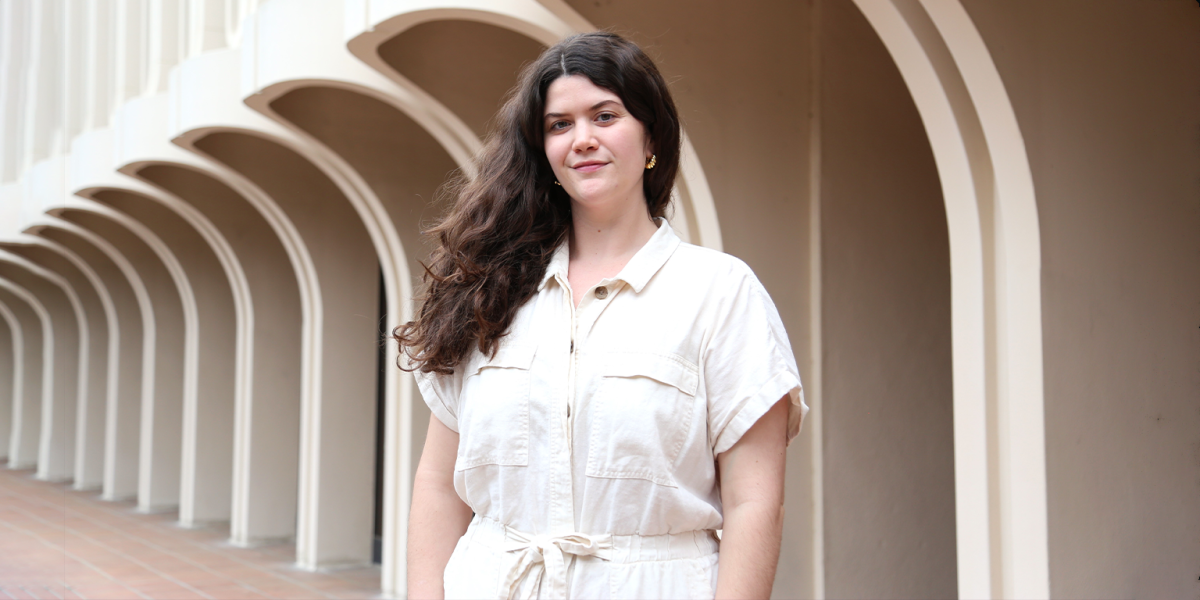A profile of MLIS alum Anastasia Armendariz

Anastasia Armendariz, MLIS '22
A hand-embroidered book of fairy tales, a delicate sculpture of eggshells inscribed with love letters, and charcoal-infused pages telling the stories of incarcerated firefighters. These are just a few of the treasures awaiting discovery in UC Irvine Libraries’s Special Collections & Archives—where history, art, and storytelling converge.
At the heart of this collection is Anastasia Armendariz, the Rare Books & Special Collections librarian. A 2022 graduate of the University of Maryland College of Information’s Master of Library and Information Science (MLIS) program, Armendariz has always been drawn to the power of stories—not just in preserving them, but in bringing them to life for new audiences.
Born in San Diego but raised in the Seattle area, Armendariz grew up surrounded by nature and narratives.
“I enjoyed exploring trails and picking blackberries with friends and siblings,” she recalls. “But I also have always been very drawn to stories. Whenever we had a babysitter over, it’d be like, ‘Oh, tell me a story about when you were a kid.’”
As a child, her love of storytelling naturally led her to libraries and museums—though she didn’t yet realize it was a preview of her future career. That revelation came later, during her undergraduate years at Georgetown University, when a work-study job introduced her to the world of rare books and special collections.
“I had never heard of rare books or archives or special collections before that moment,” she admits. What began as a student job quickly became a passion. “It was a whole new world—seeing the first printing of a novel I was reading in class or staring at a presidential signature.”
Transformative Years at INFO
Armendariz chose the MLIS program because of its strong archives and special collections curriculum. Hands-on experiences—like her graduate assistantship in teaching and learning services—rounded out her education.
“It’s hard to get experience with teaching just by being in a class,” she notes. “But being able to teach undergrads, even in hybrid and online formats during the pandemic, was invaluable.”
Her field study at UMD’s Hornbake Library deepened her love for outreach and instruction. There, she curated an exhibit on graphic artists’ resistance—her first deep dive into artists’ books, a medium that blurs the line between literature and sculpture.
Two courses left a lasting impact. A preservation class with Beatriz Haspo stood out for its creative adaptation to pandemic constraints. “She was so creative with how she presented and structured the course on something that’s very material and physical,” Armendariz recalls. Eric Hung’s “Arrangement, Description and Access for Archives” course provided hands-on experience with the Filipino American Community Archives, demonstrating the power of community-focused archival work.
A Day in the Archives
Now at UC Irvine, Armendariz’s role is a dynamic mix of curation, instruction, and outreach.
“Every day feels a little different,” she says. Some days, she’s assisting researchers or preparing instruction sessions for faculty. Others, she’s reviewing dealer lists for new acquisitions or shaping the library’s collection strategy.
Among the collection’s most fascinating items is a handmade book of fairy tales by Helena Modjeska, a renowned 19th-century actress.
“The covers are hand-embroidered, the whole book is in both Polish and English, and it’s entirely hand-drawn,” Armendariz explains. “She was on all these fancy acting tours and then came home to make this for her grandson—it’s incredible.”
Another standout is “The Smoke Inside” by Roger Peet, an artists’ book that incorporates charcoal from wildfire burn scars into its ink—literally weaving the remnants of disaster into the narrative of formerly incarcerated firefighters.
Then there’s “Mixed Messages” by Cynthia Lollis, a fragile yet intimate sculpture of eggshells printed with maps and love letters. “It’s delicate but deeply personal,” Armendariz says. “That’s what makes artists’ books so powerful—they challenge what a book can be.”
For Armendariz, the magic of rare books lies in their ability to connect people with history and stories in a tangible way.
“It went from, ‘Oh, this is cool,’ to ‘I want to share this with people,’” she says, reflecting on her undergraduate days. “I started inviting professors to special collections because I realized we had materials that spoke to what they were teaching.”
That impulse—to bridge the gap between artifacts and learners—still drives her work today. Whether guiding students through centuries-old texts or uncovering new acquisitions, her mission remains the same: to preserve stories and make them resonate.
Her advice for aspiring librarians? “Volunteer, intern, get involved in whatever way you can,” she says. “And don’t be afraid to explore different aspects of librarianship—you might be surprised by what resonates with you.”